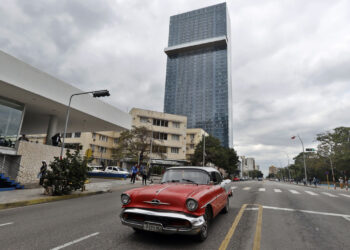During the first decade of the century, 15% of the total population living in Cuba lived in a province different from their birth. The figure has risen but Havana was and still is, the most popular migration destination on the Island
First is the courage of leaving. You leave home, your parents, and the colleagues of the neighborhood; waive routines from the tiny town where you learned as a child to sing in school, hang around, kissing … and as a teenager get into brawls at carnivals for a pitcher of inexpensive beer. You keep your heart in check and there you go, you go because in the same town you understood you didn’t have a future … or at least not the one you were dreaming of.
Then there is loneliness. You take the regular train, because you don’t have enough money for the plane, not even for the bus, and you begin to repent. Until you get to Havana and the city sucks you. Then nothing matters, not the absolute isolation to which you are reduced without friends, without family, without parents and with a rental, that if you don’t get stronger, it can take life away from you. It’s like being born again, without help from the doctor.
You have gone to seek your future, I say, from the hills of Maisí in easternmost Cuba, an area considered by demographers-since 2002 – as the municipality out of which less people leave and where fewer people come to live.
Do they feel safe there in their underdevelopment?, And I answer yes, normal, bad roads, worse transport, too much coffee, too little food and mountains. You do not want to say its name. I respect that.
I go to Havana, even though there isn’t…
Walk across the capital and you will stumble into similar stories. Those are the experiences of those that scientists cataloged as “non-native population” and Havana people, which constitute less than 80 percent of residents in Havana, call “Palestinians” if they come from the east and by the name of their province if they are from center or the west.
So strange to hear anyone on the street crying “Matanzas come here”, or “tell Camagüey to pick up the errand.” These phrases, so common, are reproduced even in films from two decades ago, and show how internal migration has become a phenomenon with implications not only demographic, but cultural.
A study published by the Spanish Agency of International Cooperation for Development (AECID), which has a technical office in Havana since 1988, found that the main determinants of internal migration in the archipelago are: the development gaps among source and destination provinces, the labor market and professional expectations according to the level of each migrant.
As a rule, it explains, people seek the possibility of higher incomes, better jobs and a sustainable standard of living. Among those needs are, for example, those that led Yasmany Perez, 26, a native of Holguin, to leave his city.
“I came in search of professional development. There I would have to settle for working in a primary school, a cultural house … or who knows what, “he says.
His story is like so many others. At the University of Oriente he graduated as Bachelor of Arts and during his years of student he changed his home address to the capital.
He now lives with his grandparents and works as a specialist in the Fund of Rare and Valuable Books at the University of Havana, “I assume cultural duties as the organization and hosting of the UH Thursday of Books” he says.
His salary is not much different with what he could make in Holguin, where the monthly average in the field of culture is 482 pesos and 510 in Education, but at least it has more work options and training.
The eastern region of Cuba has the largest migration to other areas and, paradoxically, also where there are higher percentages of people living in their native town.
Something strange no doubt, but that reflects the fact that not all provinces have the same amount of people leaving (Guantanamo, Santiago de Cuba and Granma are currently the largest emitters) and, generally, when mountain people leave , they don’t leave the territory, but remain in the provincial capital or less steep areas near their hills.
As for the gender of those moving, women prevailed until 2007 and among the housewives in working age. Causes?? According to research by the AECID, family reasons, divorces and marriages. But we Cubans know that, at least marriages are ways to reach and not the causes for the final settlement.
What statistics say
Despite how normal this subject of internal migration between Cuban families is, in universities and even on television, there are many investigations.
One of the few analyzes published in recent decades is that conducted by the Center for Population and Development Studies (CEPDE) and the Population Studies Center (DESC) of the University of Havana.
“Internal Migration Studies”, is the name of the document drawn on the basis of Census 2002 to 2007 statistics issued by the National Statistical Information System (NEIS), and takes into account the consequences of the implementation in 1997 of Decree 217 of drastically limited migration to Havana to reduce overcrowding population and existing social indiscipline.
The measure required all interested parties to apply for special permits to reside permanently. Those breaching the rule were subject to fines and could be returned to their home villages.
The results of the research, in short, stated that Habana del Este was then the capital municipality where internal migrants constituted more than 76.3 percent of its resident population. The remaining municipalities in the country had more than 75 percent of their native population.
Interestingly the analysis revealed that among other seductive destinations in the country were Matanzas, the Isla de la Juventud, Camagüey and Ciego de Avila, and showed that those who moved were mainly blacks, with high levels of schooling, and took in their destinations labor positions as managers, professionals and technicians.
With the arrival of the second decade of the century, the picture did not change much.
The first results of the 2012 Census showed that the East is still the area where most people are leaving though is the special municipality Isle of Youth, which has the highest rate with 16.4 per thousand inhabitants. The territory of lower rate of migrants is Havana and with Pinar del Rio trailing.
The bigger receivers, however, are unusual. Mayabeque shines as the main and is followed by Matanzas, Artemisa, Ciego de Avila and the capital. The statistics may seem to some rare, was marked by political and territorial division of 2010 and the Official Decree on Internal Migration, which partially lifted the restrictions that limited internal migration for years.
“While maintaining the causes and conditions that once led to the adoption of this Decree (…), it is advisable to exempt from the proceedings it establishes on certain people from other provinces who requested their transfer to permanently live in Havana, ” the text says referring to the spouses, children, parents, grandparents and grandchildren of homeowners as well as people with physical disabilities.
In the life of every man once comes the time to say goodbye to someone, or something. With those who migrate the bye, over time, can become a love – hate relationship with the place where they were born.
On one hand, they always come back, because it’s hard to let go of people, home, memories, while on the other is the certainty that there is no way back, because you don’t return to the roots when it has finished flowering. And then when you want to return, it’s too late.










